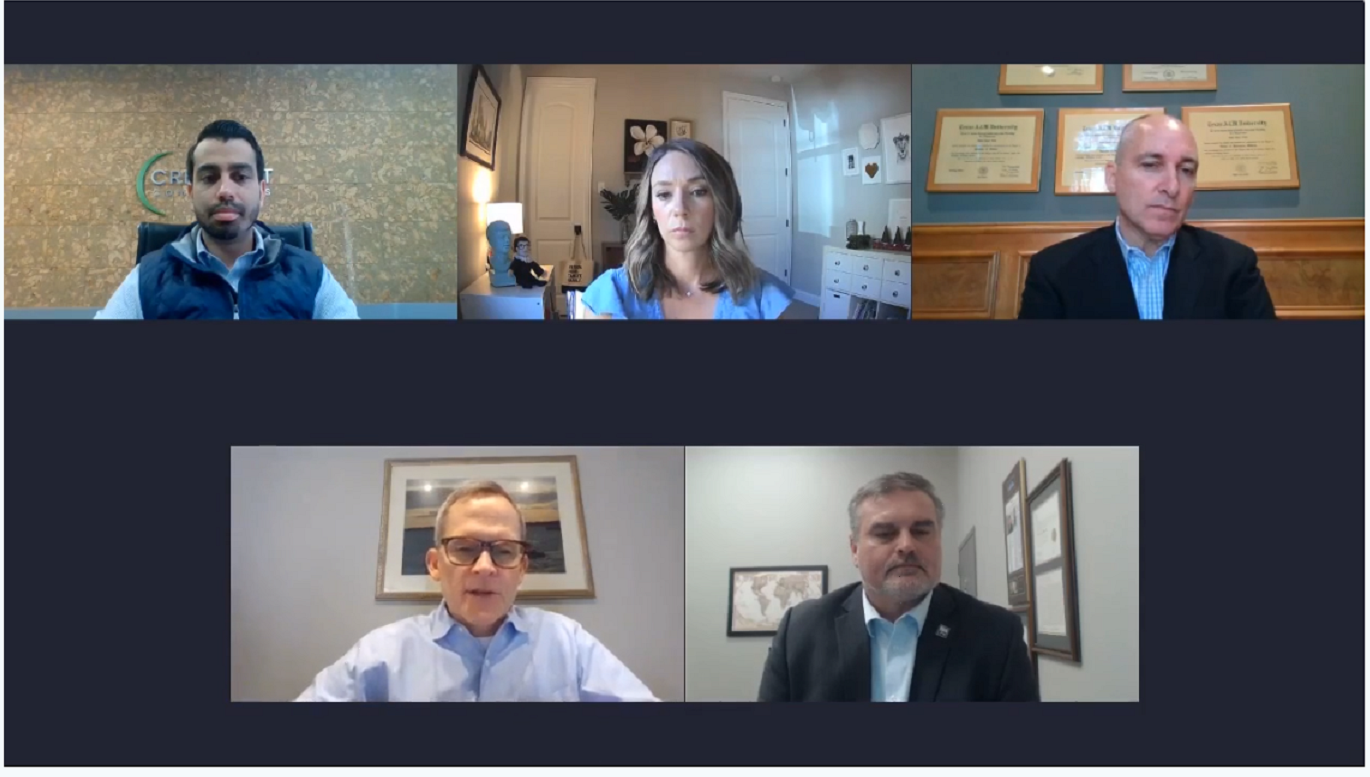In a Murky Office Market, Go Bold: NAREE Panel
Even in this unsettled leasing climate, owners must take decisive steps, according to a panel at the National Association of Real Estate Editors' annual conference.

From upper left: Sagar Rathie, Crescent Communities; Katie Walker, STG Design; Robert Fields, The Patrinely Group; Tony Wilbert, CoStar Group; Chip Watts, IREM president
Uncertainty in the office sector sometimes makes long-term planning seem next to impossible these days. Yet even if leasing activity has slowed to a crawl in many cases, office operators and property managers have plenty of opportunity to get out in front of the trends that are changing the sector.
That was a central message sent Wednesday by a panel of executives during the National Association of Real Estate Executives’ virtual conference. For office operators, the situation is the most fluid in recent memory, but that is all the more reason to ramp up efforts to adapt.
READ ALSO: Top 5 Markets for Office Transaction Volume
“We’ve been looking into our crystal ball and it’s pretty cloudy,” said Robert Fields, president & CEO of Patrinely Group. Office occupants are still uncertain about how to approach their office space in the short term, and as a result, the office leasing market often appears to be paralyzed. Leasing activity will likely take time to catch up with the oversupply in the market. To avoid making long-term commitments, negotiating one-year lease extensions is a common strategy, Fields added.
Rebuilding confidence is central to meeting the challenge of repopulating the nation’s office buildings. Owners, property managers and occupants alike must address “the psychology of your employees and how they’re going to be comfortable coming into the space,” said Katie Walker, an associate principal at STG Design.
The changes in progress at the nation’s office properties are focusing on a variety of wellness and safety measures, and have far-reaching implications, panelists noted. “Obsolescence is a big issue,” said Fields. “The next layer of enhancements we’ve made … will accelerate the obsolescence of office buildings over time,” he predicted.
Some of those changes are well documented. In response to the situation, Patrinely Group initiated on-the-fly modifications to Block 162, its 600,000-square-foot Denver office tower. Among other additions, Patrinely increased air filtration, ultraviolet air treatment and added touchless elevators.

Photo by Austin Distel on Unsplash
As extensive as the changes are, they are far from uniform. “It really depends on where you are,” noted Chip Watts, 2021 president of the Institute of Real Estate Management as well as president of Birmingham, Ala.-based Watts Realty Co. Some large blocks of space are coming on the market in Manhattan; office occupants in Watts’ hometown of Birmingham, Ala., are less likely to make wholesale changes, he reports. In a trend that may be worth the attention of U.S. office owners, IREM members in China are not reporting a major change in workplace strategies as the country has emerged from the worst of the COVID-19 crisis, Watts added.
Many tenants are rethinking their office needs, but panelists reported that the decisions do not necessarily involve abandoning or downsizing space. Current research indicates that in many cases, tenants will adopt a hybrid dividing the work week between home and office, noted STG’s Walker. But some occupants seem likely to return to occupancy as usual once a vaccine is developed and widely distributed. At any rate, she said, “It’s going to be a while before things go back to normal.”
Tenants at one of Crescent Communities’ office buildings in Charlotte, N.C., have expressed strong interest in maintaining or expanding their current footprint; the only exception is a tenant that is consolidating its current space, reported Sagar Rathie, managing director of the firm’s commercial real estate division.
Besides physical modifications, intangible measures are no less important. In particular, communicating with occupants about safety measures by signage, emails, text messages and any other available means. “You’ve got to overcommunicate,” Watt said. “That’s really the key factor to how you get somebody back in the building safe.”







You must be logged in to post a comment.